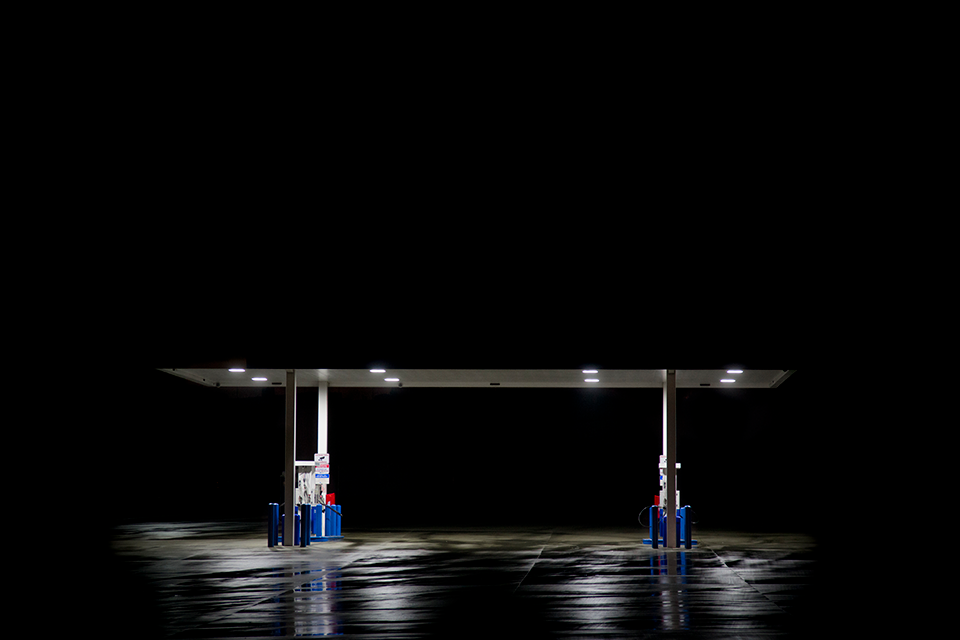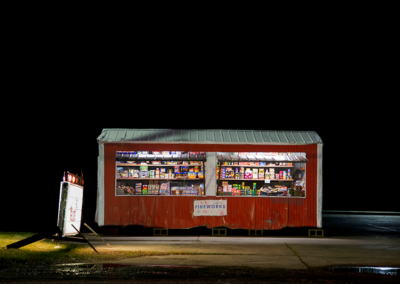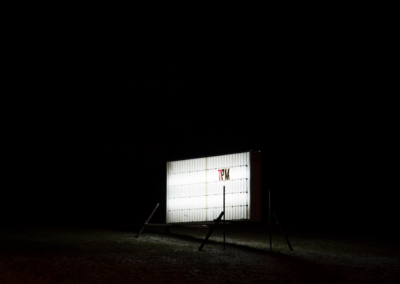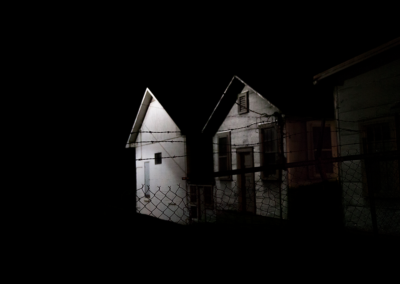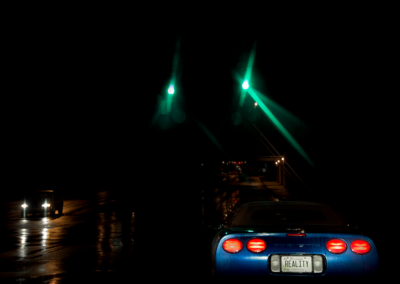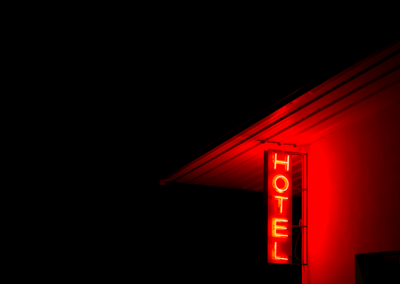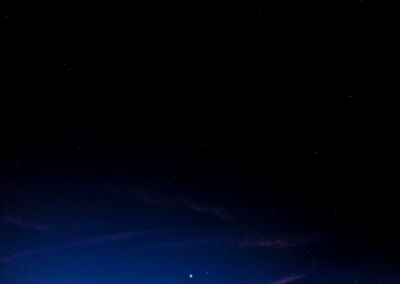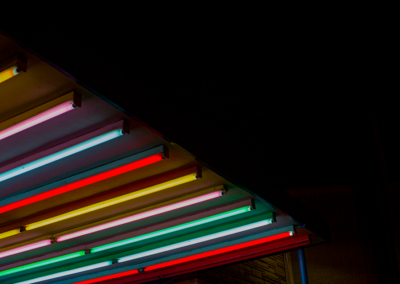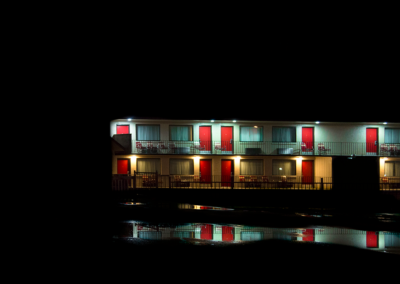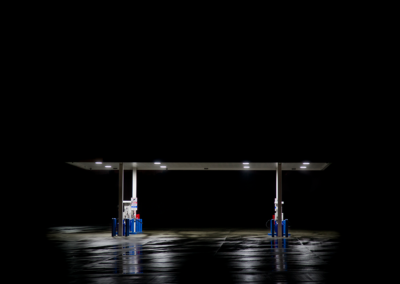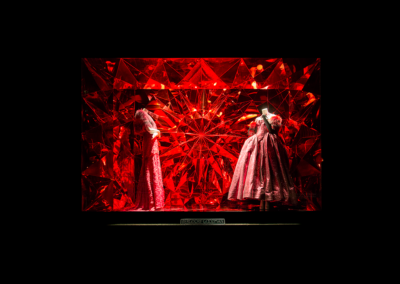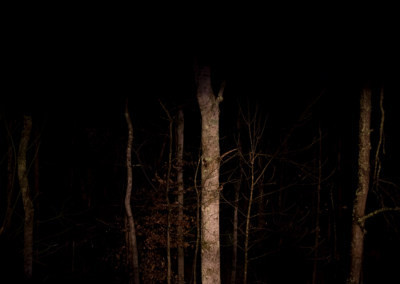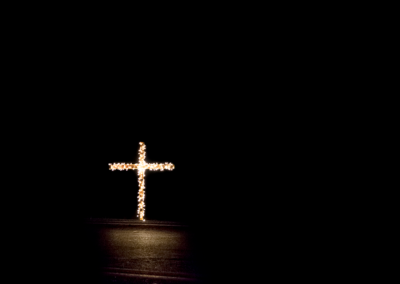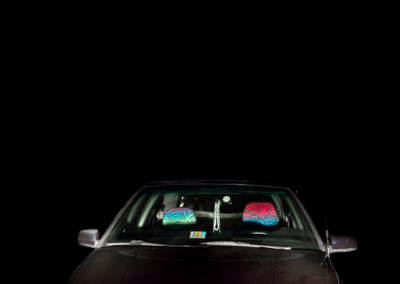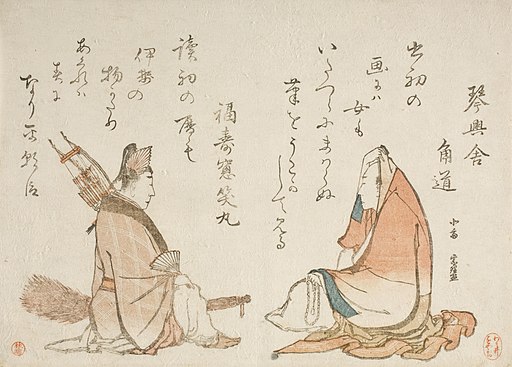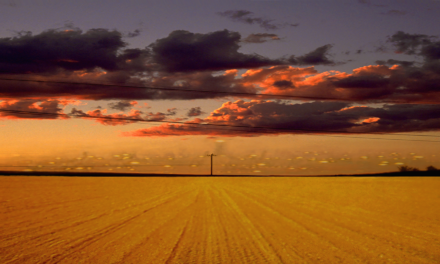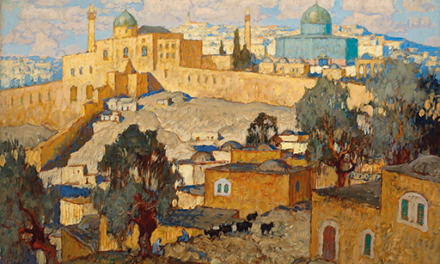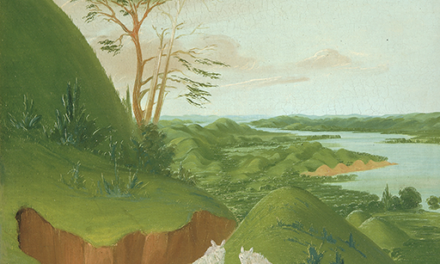American Nights
photography by Anna Beeke
Anna Beeke’s work nudges the viewer into fascinating and sometimes unnerving territory in which imagination takes flight. Her photography features enigmatic green woodlands, long stretches of dark roads pierced by oases of light, lush gardens whose secret nocturnal world is revealed in the burst of a flash, colossal cruise ships—lone “floating hotels”—that travel across the seas to distant lands while its passengers are stuck in a loop of fantasy and distraction.
“American Nights” is a product of nighttime transit. The photographer left her life in New York—the city that never sleeps because the lights are always on—and drove across the country to the bright lights of Los Angeles. In between, she found places and spaces where selective illumination and sporadic lighting vie for our attention in America’s dark, vast landscape.
We asked Anna about her series and her perspective on the meaning of light and dark in the middle of America.
Our age is hostile to night and all things dark—and so, paradoxically, we make the night darker. As our human lights blaze brighter and reach farther, from within their field night looks blacker, and our estrangement only grows.
John Daniel, “In Praise of Darkness”
What first drew you to this idea of an American night?
This project began—and the majority of the images were taken—during a month-long cross-country road trip from New York to LA. We made the journey in the dead of winter, when night falls early, and much of the driving was done in the dark. I made a few night pictures at the beginning of the trip in a style that I happened to like, and then kept my eye out for similar situations- which were abundant. Like a lot of my work, the idea evolved as I experienced the journey and took the photos, rather than springing fully formed from my mind as a perfect concept that I wanted to hunt down.
How did you go about choosing what to photograph and what to focus on for each photo?
At first, the prerequisite for most of these images was simply an aesthetic – a lit object offset by the surrounding darkness. I was interested in how against the retreating night these illuminated objects/places were purely themselves, almost archetypes of themselves. Stripped of context, it’s as if they had been brought into a studio and photographed against black for a catalog (and indeed, the subjects’ illumination often is about marketing). I began looking with intention at how neon, streetlights, floodlights, headlights illuminate gas stations, motels, crosses, roller rinks: beacons of Americana drawing you in from the dark, signaling some kind of importance.
What aspects of America and its relationship to nighttime did you want to capture?
The project is about night, but also very much about light. We live in an age of artificial light, especially in America, which, along with Europe, leads the world in light production (and therefore light pollution). Most of us take it for granted that the lights go on at night, but in the course of human history, it’s a very recent privilege, and the privilege of a developed nation. I am curious about how we have changed the night landscape with light and what things and places are so important or essential to us that we must be able to see them in the dark. We use light for safety, as floodlight on a home, and utility, as street lights and stop lights, and religion, as a cross covered in Christmas lights, and most often for commerce, as a lit up store window, a gas station glowing brightly on the side of a lonely stretch of road, a neon hotel sign that draws the weary traveler in out of the night as long ago a candle in a window might have. Some of the scenarios aren’t expressly meant to be seen in the dark for any purpose, rather they are just caught in the headlights.
Reflecting on this series from 2015-16, does anything speak to you of America’s current political crisis, especially the most recent events?
Obviously America then was a very different place than now, but the way it looks – the things you see in pictures like these – hasn’t really changed. When I look at these images in light of recent events, I think of the age-old metaphors of light and darkness, and also of the light in the dark or the light at the end of the tunnel.
How does the interplay of night and illumination within what you call the “vast expanses of America” differ from a city like New York or Los Angeles?
Big cities obliterate nature’s natural darkness; they erase night. The sky is diluted by so much light that it is always a slightly glowing thing, dim but not truly dark. There is so much light in the cities that it spills out into the sky over less populated areas of the country where, conversely, it makes the sky darker – by canceling the starlight. Add to this a very bright light source, as in these photographs, and the sky becomes pitch black. Our eyes and a camera work the same way – when you focus on the light, the contours and variations of the shadows disappear and the surrounding dark becomes even darker.
Darkness can evoke a wide range of emotions in people; what effect does it have on you?
We humans have always had a complicated relationship with the night. Being vulnerable in the dark, we are fearful of it (even now, as we generate so much artificial light that we are losing the stars). On the other hand, night is the time when the dream world cracks open our subconscious and makes anything seem possible. In our collective imagination, the nocturnal world is full of danger, but also magic and mystery. I personally love the dark. It makes me feel cozy and safe; it helps me turn inward and think more creatively. I know this isn’t the most widely shared feeling but the period leading up to winter solstice, as the days grow shorter, is my favorite part of the year.
In what ways do the ideas in “American Night” connect to your other projects?
My interest in exploring the night – what it means to us psychologically and how we keep it at bay – crosses over into other projects, most notably “Midnight in the Garden,” an ongoing series about the nocturnal life of a city garden that doubles as an exploration of how our psyches render the world differently at night. Inasmuch as “American Nights” looks at how we have changed the night landscape with artificial light, it follows a major theme that runs through most of my work: how humankind alters and interacts with the natural world in the Anthropocene. I first examined this topic with “Sylvania,” which deals with the intersection of nature, imagination, and myth in the American woodlands. The more commercial, man-made subjects of “American Nights” find a connection with “At Sea,” a project that explores the idea of leisure through the American cruise ship industry (pre-pandemic). And, clearly, America itself is a persistent muse.
What do you hope stays with the viewer after looking at these photos?
This is a question I often have trouble answering because I prefer for my pictures to ask more questions than they answer, to provide just enough information to spark the imagination. Everyone will undoubtedly see these images slightly differently, imbuing them with their own memory and mythology. There is a distinct lack of people in this project, partly because I want the viewer to become the protagonist, to project themself into these spaces and situations in order to reflect upon their own unique relationship with the night and these stereotypically American subjects.
Anna Beeke is a documentary/fine art photographer and videographer based in Los Angeles. She has an MFA from the School of Visual Arts (2013), a certificate in photojournalism from the International School of Photography (2009), and BA in English from Oberlin College (2007). Anna was chosen for PDN’s 30 in 2015, and among other honors has received the 2015 Wallis Annenberg Prize and the 2012 Humble Arts and WIP-LTI/Lightside Materials Grant. Her first monograph, Sylvania, was published by Daylight Books in 2015. Most recently, she worked as a videographer on the Netflix documentary series Unnatural Selection. Anna’s work has been exhibited across five continents and she is represented by Uprise Art.

